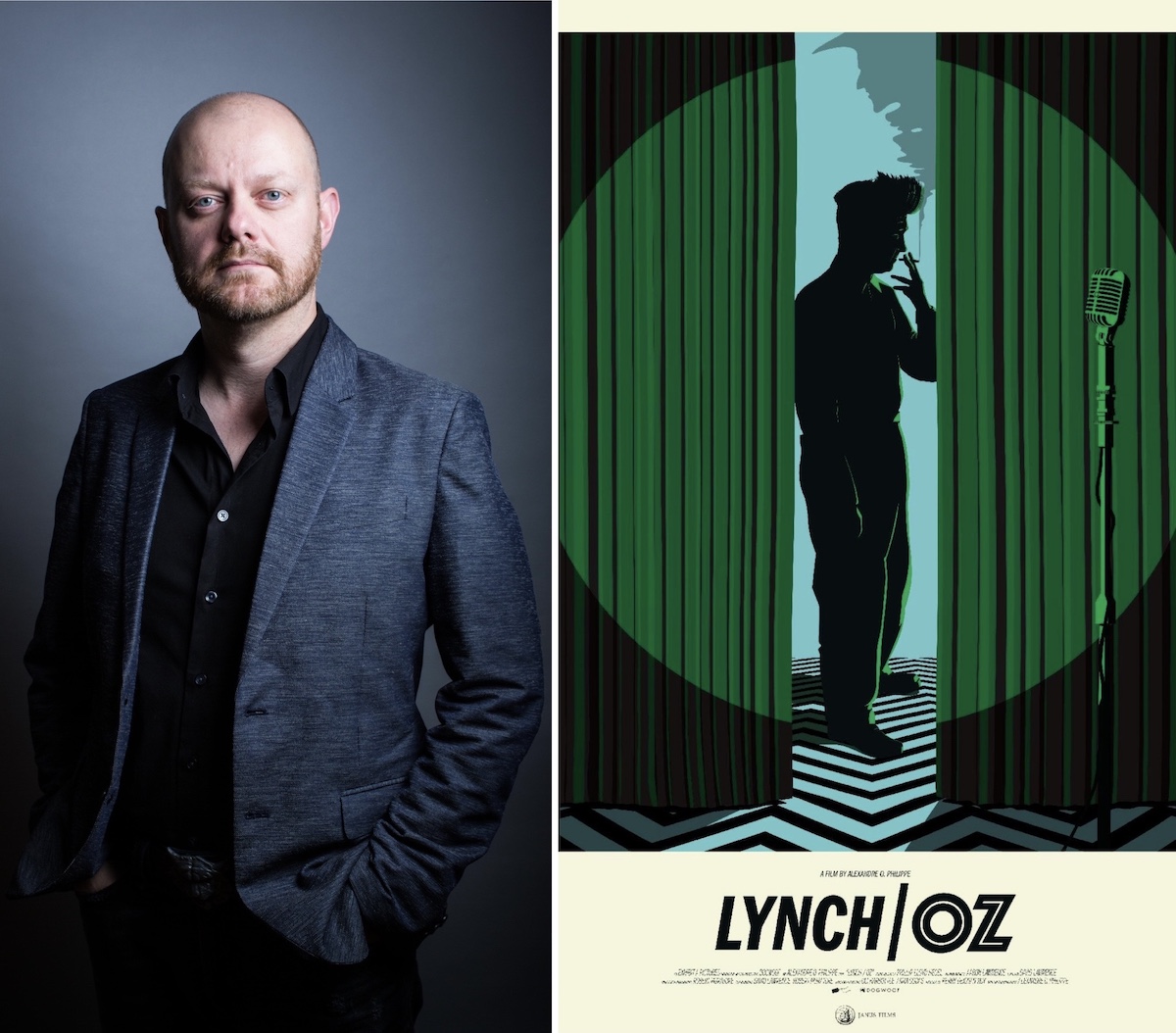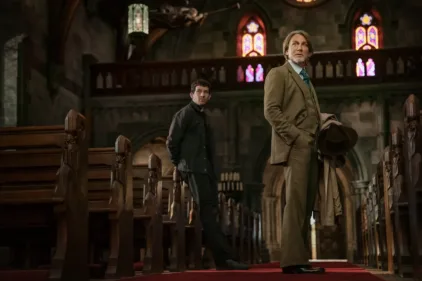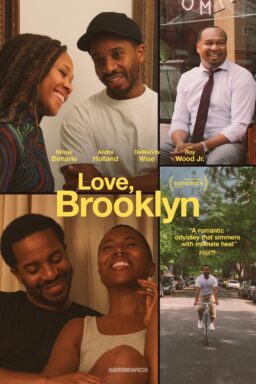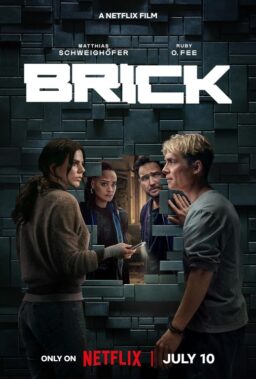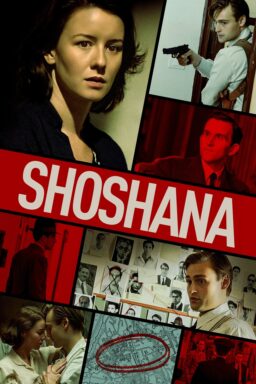After experiencing David Lynch’s complete body of work on the big screen last year, thanks to Daniel Knox’s masterfully curated retrospective at Chicago’s Music Box Theatre, my soul was ready for documentarian Alexandre O. Philippe’s latest work, “Lynch/Oz.” As he did in “78/52: Hitchcock’s Shower Scene” and “Memory: The Origins of Alien,” Philippe brilliantly illustrates how cinema at its highest level is a gift that keeps on giving, illuminating the ways in which dreamscapes enable us to understand ourselves and others with greater clarity. Taking the form of six visual essays, each narrated by a filmmaker or critic, the movie illuminates a wealth of provocative ways in which “The Wizard of Oz” is meaningfully reflected in Lynch’s oeuvre.
“Yellowjackets” director Karyn Kusama’s analysis of “Mulholland Dr.”, which still stands as my all-time favorite film, is one of the best I’ve ever heard, reminding us cinephiles of why we crave revisiting the work that caused us to see the light. The film’s other insightful narrators include “Room 237” director Rodney Ascher, “The Endless” co-directors Justin Benson and Aaron Moorehead, “A Ghost Story” director David Lowery, LA Weekly film critic Amy Nicholson and Wicked Witch enthusiast John Waters. After screening “Lynch/Oz” at Knox’s latest retrospective in Dallas, Philippe spoke with me at length via Zoom about his creative process, cinematic obsessions and desire to champion the art form by causing us to view it in a new way.
“Lynch/Oz” made my Top 10 List of 2022 on RogerEbert.com, and I am so elated to see the film finally receiving a theatrical release in the U.S.
Well, thank you! I do wonder whether Roger Ebert would have appreciated my work. I went to a couple of the film deconstructions he did in Boulder, Colorado, and the first subject was “Mulholland Dr.” I did interject a couple of times with observations, so I communicated with him from afar in the audience. Those were really fun and very inspiring. It’s interesting how some of my earliest memories are film memories. “Vertigo,” “Eyes Without a Face” and “Scanners” all had a big impact on me at a young age. I don’t know if you can call yourself a cinephile when you’re twelve years old, but I think I had the trappings of it. I grew up in Switzerland and on every Sunday, I would have curated film programs for my parents and their friends. I would introduce a film, screen it on VHS, and then do the Q&A afterwards. We would watch Hitchcock films for a few weeks, Spielberg films for a few weeks…
That sounds quite similar to the Hitchcock retrospective I held in junior high for friends and family, complete with programs and post-screening discussions.
Well there you go! So when I moved to Denver and I heard that Roger Ebert was analyzing films with an audience, I went to his “Mulholland Dr.” screening, and it really blew my mind. I subsequently did a series that was inspired by Roger’s called “The Language of Film,” where it was basically the same model. I picked a film every week and did a live stop/start deconstruction with the audience. It’s so fascinating to me because, on one hand, you’re moderating but you’re also getting so much from the audience, and they will start pointing things out that never in a million years would you have imagined, which is so cool. Of course, with a film like “Mulholland Dr.”, those sorts of discoveries are endless. We went down the rabbit hole with Roger on that film—I think it was a five-hour affair—but I remember that there was a funny little theory I had that he kind of shut down.
There is the jitterbug sequence that opens the film, which of course is linked to the deleted “Jitterbug” number in “The Wizard of Oz”—we almost had it in “Lynch/Oz” during Amy’s chapter, but eventually decided against it. I feel there are some really interesting visual puns in “Mulholland Dr.” In the moment when Diane is furiously masturbating on the couch, there is this POV shot of a weird fireplace with rocks as the camera goes in and out of focus, and my interpretation of it is that she’s “getting her rocks off.” Then you see the couple who Betty had met earlier at the airport creeping under the door to haunt Diane. The woman—played by the mother from “Eraserhead,” Jeanne Bates—certainly has a witchy vibe, and when you see her and her husband walking toward Diane’s bedroom, they are sort of jittery. So I thought, ‘What if it’s a visual pun, a play on ‘don’t let the bedbugs bite’—don’t let the jitterbugs bite?’ I thought they might be the jitterbugs of “Mulholland Dr.”, and Roger was like, “Well, no, that’s too far-fetched.” [laughs] But I still think it’s one way to interpret those characters.

Lynch is the sort of artist who wants his work to invite many different interpretations, which is why he refuses to explain it.
Yeah, and obviously, we could talk for hours about film as a dream. I think when you have filmmakers who tap into what Lynch calls “the room over there,” meaning following the flow of intuition and inspiration and ultimately tapping into the infinite, if you will, and trusting that, then things start happening within their films that work on multiple levels. And so, of course it’s going to hit people in different ways. Obviously there is a design and a truth for Lynch, but there are an infinite amount of ways one can interpret it. For me, movie watching is movie rewatching. When you’re faced with a great movie, the more you watch it, revisit it and delve into it, the more new ways of seeing it are going to start coming to you, and that’s the joy of it.
The shower scene is so extraordinarily complex. There’s a reason why that scene hit such a nerve at the time and continues to have this incredible ripple effect. I could be making films about the shower scene for the rest of my life and still have a fulfilling life as a filmmaker because there’s no end to it. You can put that scene in front of so many different kinds of people, whether they are filmmakers, architects, choreographers, whatever, and they will show you something in it that you’ve never seen. That process of discovery is what I’m so passionate about and it’s what I love the most about what I do.
You can learn so much about a work of art by viewing it through the prism of another, as you and your editor David Lawrence illustrate in how you show the ways in which “The Wizard of Oz” and “It’s a Wonderful Life” are telling the same story.
The joy is when someone like Amy Nicholson mentions this sort of observation, and then of course, the immediate thing you want to do is delve into it by looking at the films side by side to find the connections. What’s really beautiful is that beyond the story beats and similar narrative arcs of those two films, you have these sorts of mirror images that make it seem as if you’re tapping into something primordial. It’s almost like movies have a way of talking to each other across the ages. They resonate culturally almost like living organisms in a way that sort of goes beyond our comprehension. The image of the characters walking down the Yellow Brick Road in “The Wizard of Oz” mirrors the shot of George Bailey walking down the bridge in “It’s a Wonderful Life,” just as George’s dance where he stumbles into the pool is similar to the clumsy dance moves of the Scarecrow, which was a great discovery that David made.
Finding these sorts of poetic connections, shared visual motifs and other ways that movies can be mirrors of one another enables the work that we do to become an art form in itself. We don’t just have somebody talking about a clip and then we show a clip. No criticism bugs me more than when people say our films are glorified DVD bonus features because they clearly don’t have a sense of the amount of work and artistry that goes into what we do. Films about film are a legitimate art form when you ensure that every clip tells a story and lands on multiple levels. You’re not just going from A to B, but allowing the images to resonate in a deeper, more poetic and lyrical way. I love this exercise, and I am very fortunate to work with an amazing editor like David.
What fundamentally makes my work a very different exercise than writing a book about cinema is that they have to be a dream in and of themselves. When you’re making a film—whether it’s a fiction film, a documentary or a film about film—you are asking someone to pay fifteen bucks, enter a dark theater and have a good, compelling, interesting time for 100 minutes. You need to meet or exceed their expectations by the time that the lights go up, and I take that contract with my audience very seriously. Now, of course, you’ll never be able to please everybody, but I think films about films have to be in and of themselves a cinematic experience. If they’re not, then I am failing at my job.

I script my films first because, to me, it has to work on the page before it works on the screen. I always have clip suggestions in mind, but I tell David that if he has a better idea, we’ll audition other clips. So I give him the script and then he’ll cut a version of the film. There’s a lot of back and forth during this process, and then when we start getting into the microlevel of making every single moment work, this is where I love to tap into his brain, which is one of a true cinephile. He’ll have folders of multiple clips that could work for each moment, and so when I’m not sure about a certain clip, we’ll start auditioning several others while geeking out about them. Sometimes a particular clip that we really want won’t work under the Fair Use regulations, so we’ll have to let it go and find another solution.
We work with the law firm Donaldson Callif Perez, LLP, who are the best at what they do. Kerry Deignan Roy, the producer at my company Exhibit A Pictures and my longtime business partner, works very hard at this and is very thorough. I usually have to convince her of any clip usage before we take it to the attorneys. I’ve been doing this long enough now that I know what’s going to fly, what’s probably not going to fly that I shouldn’t try, and then what are the gray areas that we need to discuss. For me, Fair Use comes with a profound respect and understanding of copyright, and I want to be very clear about that. The films that we make are not about stealing someone else’s work, they’re about interpreting and reinterpreting it. We want to show these works in a different way through a different lens.
In that way, we are promoting these works and making sure that they continue to be in the public eye. When people go see “Lynch/Oz,” the first thing that I hear them saying afterward is, “Oh my gosh, now I want to go back and rewatch ‘The Wizard of Oz’ along with every single David Lynch film!” And that’s what it is about—creating a space for a dialogue and an interpretation and inspiring people to reconnect, or in some cases, connect for the first time with these classic films, and to keep them alive in our global consciousness.
What was the impetus for “Lynch/Oz”?
I honestly don’t remember the moment when the idea first came to me. I know that it clearly had been floating around in my mind for a while. I certainly had been obsessed with Lynch for a long time and had always wanted to make a film about him. In 2012, I was showing my film,“The Life and Times of Paul the Psychic Octopus,” at a festival, and Oli Harbottle, the Chief Content Officer of Dogwoof, was there. He attended the Lynch masterclass I gave at the festival and he was blown away by it. Dogwoof went on to distribute “78/52,” “Memory,” and “Leap of Faith: William Friedkin on ‘The Exorcist,’” which led to Oli and I meeting briefly for coffee at the 2020 Sundance Film Festival. I told him that I finally had a concept for a film on David Lynch. When I told him that the title was “Lynch/Oz,” he said, “We’re in,” and that’s all it took. He never questioned it.
What’s remarkable about it now in retrospect is that I didn’t have the evidence to prove that there was enough to this topic to make it a feature, unlike with the shower scene. Beyond “Wild at Heart,” the red shoes, the curtains and a few other things, I wasn’t really convinced that this subject would fill more than a short. But somehow, I felt in my gut that this was the right project to do, and when that happens, I just follow it. Of course, the moment we started the interview process with the likes of Amy, Rodney, Karyn, John, Justin, Aaron and David, it was clearly evident that you could make a whole series of movies about “Lynch/Oz” because everybody has a different take on it.

Tell me how the film was whittled into these six narrated segments.
It was a multi-step process. I think it’s important to note that this is a pandemic movie. We literally started working on it in March 2020 just as things were shutting down left and right, The first step of the process for me was to find participants who were all in, who understand your language to the point where if you say, “I’m making this film called ‘Lynch/Oz,’” they will instantly get it, and all of those people got it. If they even have to ask, “What does that mean?”, then you are probably talking to the wrong person. Once we had them selected, I set up what I call a jazz interview where I got each of them on the phone and recorded our conversation on my iPhone—the shortest one was about 90 minutes and the longest was about three and a half hours. We would riff on the theme of “Lynch/Oz,” and my job at that point is to search or fish for a thesis. I go in all of these directions and follow their little personal Yellow Brick Road as it were inwardly, and eventually, some things started emerging.
Basically the point was for me to keep fishing until I felt like we had enough material. After I transcribed our conversation, I would use it to write their chapter. The flow of it would be affected by what could potentially happen visually because every single moment had to land. Eventually I would send them the script and we would usually go back and forth a few times with edits. It became a bit of a collaborative process up until the point where we were both happy with the script. Then I sent them to a recording studio to do their voice-over, and that’s what you have in the film. The only person we didn’t want to do this with was John Waters, whom I interviewed at the recording studio so he didn’t have to come back. I am very happy with his chapter, and think it’s a beautiful refresher after the darkness of Rodney’s.
Though I interviewed each person out of sequence, someone would mention something in their interview that was kind of a peripheral part of their thesis, but the next person would start really delving into it. It’s almost like they were sort of passing on the baton from interview to interview, and so the sequence of those six chapters came totally organically. It took me literally five minutes to say, “It’s going to be Amy, Rodney, John, Karyn, Justin and Aaron, and then David Lowery.” The grand finale of David’s chapter brings it home, “Oz” pun intended. It is really what the film is fundamentally about, that beyond David Lynch and “The Wizard of Oz,” this is a film about the mysteries of influence and inspiration on the creative process. For those of us who are now filmmakers, there were a handful of films that had a massive impact on us as kids, and when you grow up, you are, in a way, trapped by them.
They will keep coming back again and again in your work whether you are conscious of it or not, and that’s a beautiful thing, this idea that films are a formative experience that essentially becomes an integral component of your cinematic DNA. I think that “Lynch/Oz” makes the case very strongly that “The Wizard of Oz” is that film for David Lynch, but I want to make sure to say also that my film is not about solving the David Lynch riddle. There’s nothing to solve about him or the creative process. It’s about opening new doors and windows by putting a new lens or filter on these extraordinary films and seeing them in a different light. It’s really an invitation to continue to reinterpret and revisit those works.

I would like to ask about the scenes you bookended the film with that are set in a theater occupied by a Lynchian Master of Ceremonies.
The idea was to essentially bring the audience into a world that is theatrical because theatricality is a key to Lynch. I wanted to take the viewer beyond the curtains and into a state of transcendental meditation, if you will, in order to establish the very thin membrane that exists between Lynch and Oz. In chapter one, we go through the emerald curtains, which subsequently become red as we go deeper and deeper until we bring the viewer back out through the emerald curtains and into the theater at the end. That’s why we merge the shot of David Lynch asleep with Dorothy asleep as we go way out in the field of relativity before finding our way home, having come out of the dream of “Lynch/Oz.” I always envisioned this friend of mine, Sid Pink, who I call the Lounge Wizard—which is how he is credited in the film, being a part of this documentary because he is a character out of a Lynch movie, down to his own wardrobe, which you see him wearing.
We actually shot this sequence inside an old opera house in Central City, Colorado, because it’s one of the few theaters that gave me and my invaluable cinematographer/co-producer Robert Muratore the permission to shoot with a drone. That came with a lot of challenges because the drones are responsive to light, so we had to light the theater in a particular way. There were always danger zones where it could crash, and it did a few times. In fact, there’s one shot that was certainly not intended, but I’m glad I kept it in, where the camera begins close to the microphone before dipping way down below the stage. The drone nearly crashed in that moment, but it resulted in footage that my brilliant sound designer, Phillip Lloyd Hagel, accompanied with the noises of machinery and levers that speak to the Man Behind the Curtain…
As well as industrial sounds from Lynch’s past in Philadelphia that turn up throughout his work.
Exactly, I wanted to create those connections in a visceral way. The opening of “Memory” is also very visceral in that sense. In fact, pretty much every film I’ve made since “Doc of the Dead” has an elaborate opening sequence that welcomes you into the world of the film in a way that is not just about paying homage to the film itself, but is taking you into an environment that is going to reveal aspects of the film that you’ve probably never thought of before. We also had all kinds of complications because Sid had been attacked a few years ago in Paris and was left for dead with a hole in his skull. He somehow survived, but still has seizures periodically. The day before we were to shoot at the opera house, I picked him up and he had a massive seizure in the car, so I took him to the hospital. It was the only day that we could get the opera house, so we had to completely reinvent the sequence and figure out a way to shoot it without him before adding him in later with footage shot in front of a green screen.
So he becomes a “recording” like Richard Green’s Magician at Club Silenco.
Totally! As a result of that, some interesting ideas came, such as the theatrical moment of the two hands opening the curtain. It caused the sequence to become more in line with the vibe of the film. We scheduled Sid’s green screen shoot for a month later, and the day before, he had another seizure and went back to the hospital. At that point, I was heartbroken. Kerry took me aside and said, “If that happens again, we’re going to have to find somebody else,” and just as Justin Theroux is told, “This is the girl,” in “Mulholland Dr.”, I was like, ‘No, this is the guy!’ [laughs] Thankfully, the third time, everything went great. I love him so much and he’s really proud to be in the film.

You illustrate how these different works of cinema can be in conversation with one another even without their own creators being aware of it. I was reminded of my favorite paper that I wrote in college which compared Ingmar Bergman’s “Persona,” Robert Altman’s “3 Women” and David Lynch’s “Mulholland Dr.”
Oh perfect! Lynch is the man behind the curtain, or the elephant in the room—he’s kind of both. This idea of the unconscious and this kind of quasi esoteric idea that films are sort of living organisms in a way, that they find their way into the culture whether we want them to or not, and that if there is something that needs to be expressed, they will find the right people to tell that particular story, manifests itself in “Memory: The Origin of ‘Alien.’” It’s completely about that particular sort of journey and serendipity. Mythology finds a way to come back and express certain ideas in culture at times when we need to hear it. I’m not suggesting that a movie or a story is a living, breathing organism, or that the Furies of Greek mythology are actual monsters, but in a way, they are because they are a part of us.
The collective psyche evolves and changes. It’s the reason why a film shows up at a certain time, and then for seemingly no rhyme or reason, everybody goes to see it, talks about it, and it hits this major chord. That’s not necessarily because the film is one that people want to see at that particular time. In the case of “Alien,” it was the movie that people needed to see in 1979, but it was also four decades ahead of its time. In the case of “Psycho,” the idea had been boiling that the ’50s were over, and the moment of Mother ripping the curtain open essentially announces, “Welcome to the ’60s! We’re not pretending anymore, we’re in a different world now.” So people freaked out in part out of recognition that this film was telling them the truth, and that’s why it resonates.
One connection between films that has obsessed me in a similar way is how the ape wielding the bone in “2001: A Space Odyssey” mirrors Daniel Plainview wielding the bowling pin in “There Will Be Blood.” Though Paul Thomas Anderson affirmed that this was not a conscious homage, the spiritual bond between them is unmistakable.
Wow! Whether that mystical connection really exists or not is beside the point. The fact that you can see those unconscious connections is what matters. It’s interesting because when you just mentioned that scene, I recalled how Daniel Plainview really does kind of walk like an ape in that moment! You’re absolutely right. If movies are collective dreams, which they are, then of course some of these images are going to resonate and connect in ways that may sometimes take us decades to discover. It’s so interesting when you start looking at these little mirror images because, at the end of the day, the pool of the unconscious works in mysterious ways.
For more information on “Lynch/Oz,” visit the official sites of Janus Films and Exhibit A Pictures.

